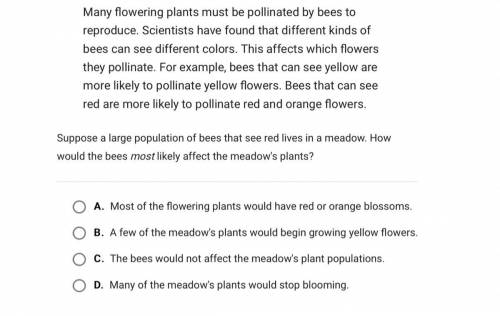
Biology, 04.02.2021 21:20, quigley523
Many flowering plants must be pollinated by bees to reproduce. Scientists have found that different kinds of bees can see different colors. This affects which flowers they pollinate. For example, bees that can see yellow are more likely to pollinate yellow flowers. Bees that can see red are more likely to pollinate red and orange flowers.
Suppose a large population of bees that see red lives in a meadow. How would the bees most likely affect the meadow's plants?
A.
Most of the flowering plants would have red or orange blossoms.
B.
A few of the meadow's plants would begin growing yellow flowers.
C.
The bees would not affect the meadow's plant populations.
D.
Many of the meadow's plants would stop blooming.


Answers: 3
Other questions on the subject: Biology

Biology, 22.06.2019 01:00, catalanb474
All but one describes an effect of aging on the digestive system. a) decreased acid secretion b) decreased elasticity of stomach c) capacity to resist damage decreases d) food remains in stomach for less time
Answers: 1

Biology, 22.06.2019 03:00, seahorse0
To answer this question, researchers studied populations of the dusky salamander (desmognathus ochrophaeus) living on different mountain ranges in the southern appalachian mountains. the researchers tested the reproductive isolation of pairs of salamander populations by leaving one male and one female together and later checking the females for the presence of sperm. four mating combinations were tested for each pair of populations (a and b)—two within the same population (female a with male a and female b with male b) and two between populations (female a with male b and female b with male a). the proportion of successful matings for each mating combination was measured. for example, when all the matings of a particular combination were successful, the researchers gave it a value of 1; when none of the matings were successful, they gave it a value of 0. then the researchers calculated an index of reproductive isolation that ranged from 0 (no isolation) to 2 (full isolation). the reproductive isolation value for two populations is the sum of the proportion of successful matings of each type within populations (aa + bb) minus the sum of the proportion of successful matings of each type between populations (ab + ba). the table provides data for the geographic distances and reproductive isolation values for 27 pairs of dusky salamander populations.
Answers: 1

Do you know the correct answer?
Many flowering plants must be pollinated by bees to reproduce. Scientists have found that different...
Questions in other subjects:


History, 25.06.2021 23:50

History, 25.06.2021 23:50

Mathematics, 25.06.2021 23:50

English, 25.06.2021 23:50



Mathematics, 25.06.2021 23:50


Spanish, 25.06.2021 23:50






